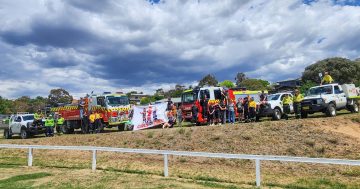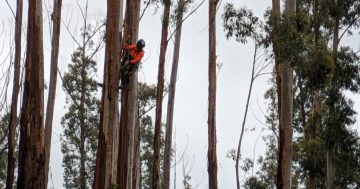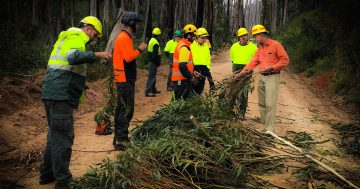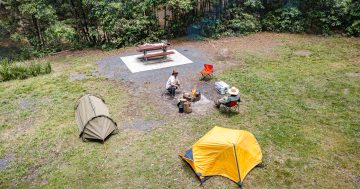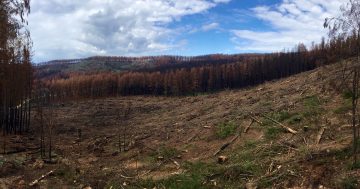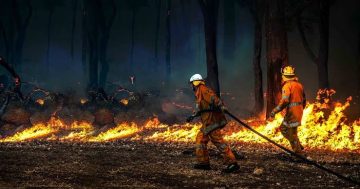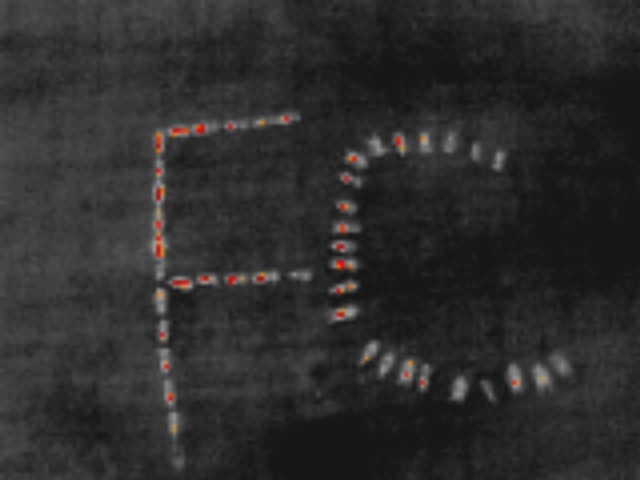
New Forestry Corporation of NSW firefighters saw firsthand how infrared technology is used on the fireground. Photo: Forestry Corporation of NSW.
Budding firefighters saw themselves in a whole new light when they took part in a recent pre-season training camp at Tumbarumba.
Forestry Corporation of NSW’s 40 new firefighting recruits and contractors from across the state were put through their paces in preparation for the bushfire season ahead.
The camp covered topics such as fire behaviour, firefighting tactics and strategy, leadership and communications, but it was the range of high-tech equipment that really blew the newcomers’ minds.
Drones with thermal imaging cameras are used to map firelines during times of low visibility, or when conditions are too dangerous for helicopters or planes to fly.
Forestry Corporation of NSW fire training and operations officer Adrien Thompson said the drones provide a real-time display of visual and thermal imagery to the fire crew on the ground.
“The visual imagery component is primarily used to locate and determine potential edges of the fire by observing rising smoke, which can be seen several kilometres distant,” he said.
“Forestry’s custom drone software enables the measurement of magnetic compass bearing to the observed smoke and so by taking the bearing from multiple sites, the fire location can be pinpointed through triangulation.
“When close to the fire, the thermal imagery component is a critical tool in the management of fire in the landscape, specifically in the detection of fire edges, hotspots and tree stumps that may be burning internally or below ground.”
When carrying out hazard reduction burns, thermal imagery provides the fire team with a way to determine the depth of burn from the road edge and its rate of spread through the forest.
“In a wildfire situation, thermal imagery is used to determine the location of the active fire edge, the extent of the burnt area, and the location of hotspots that may require longer-term monitoring,” said Mr Thompson.
Custom drone software enables the visual and thermal imagery to be recorded in real-time, along with its location in the landscape, while Forestry Corporation of NSW’s use of tablets and mobile mapping services on the fire ground enables fire location and extent information to be sent back to fire headquarters in near real-time and shared with other fire management services.
New recruits from the NSW North Coast, Mid North Coast, Bathurst, Deniliquin, Batemans Bay, Eden, Bombala, Tumut, Moss Vale and Baradine were trained in essential firefighting skills at the camp, and they learnt how to operate the range of appliances and equipment used at fires.

New Forestry Corporation of NSW firefighting recruits prepare to see themselves in an infrared drone image. Photo: Forestry Corporation of NSW.
Mr Thompson said the intensive training program was designed to get new recruits nationally qualified and ‘fire ready’ as forest firefighters.
“The COVID-19 pandemic has added complexity to this year’s training, but we have changed our approach to make it work and make sure we are prepared for the bushfire season ahead,” he said.
Forestry Corporation of NSW’s bushfire training camps are essential for developing a skilled and capable workforce for the fire season.
Mr Thompson said the training program is comprehensive and recruits also get the opportunity to learn other skills such as using chainsaws, first-aid, chemical use and driving 4WD vehicles and tankers.
“Safety is always at the top of this list; our firefighters’ wellbeing is our biggest concern and it all comes back to correct training and procedures,” he said.
“We take our firefighting responsibilities incredibly seriously and our training ensures everyone from our most experienced firefighter through to our newest recruits are fit and ready to be deployed to the firefront.
“Crews assist on large bushfires across all tenures within their local areas, interstate and even internationally so we need to ensure we are at the top of our game.”
Forestry Corporation of NSW is responsible for preventing and managing fires across two million hectares of state forests, and also works collaboratively with the NSW Rural Fire Service, Fire and Rescue NSW, and NSW National Parks and Wildlife Service across all tenures when managing fires throughout large areas of the landscape.








